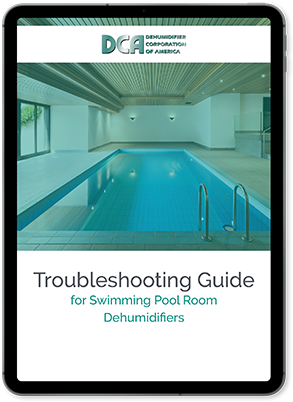 Controlling the relative indoor humidity in your fitness center will reduce mold and bacteria buildup and produce happy patrons. Without dehumidification systems leading to unacceptable indoor air quality, these facilities tend to get grim pretty fast—when not controlled, moisture buildup from patron sweat results in foul odors, shorter equipment lifespans, and the proliferation of diseases.
Controlling the relative indoor humidity in your fitness center will reduce mold and bacteria buildup and produce happy patrons. Without dehumidification systems leading to unacceptable indoor air quality, these facilities tend to get grim pretty fast—when not controlled, moisture buildup from patron sweat results in foul odors, shorter equipment lifespans, and the proliferation of diseases.
Engineers and operators for fresh water and wastewater treatment facilities know the hazards and frustrations that come along with maintenance and housekeeping for the facility. These operations inevitably raise the moisture content of the air, which leads to rust and corrosion of the equipment, and eventually to the presence of mold and mildew within the facility.
Dehumidification systems remove unwanted moisture from a building’s internal environment to help control its atmosphere’s relative humidity and dew point. In commercial applications, dehumidifiers help contribute to a pleasant work environment, aid in room temperature regulation, and help control condensation causing mold or mildew formation. In industrial applications, dehumidification systems aid in controlling your product’s moisture content, enable smooth process operations, and maximize production efficiency.
Relative humidity (RH) is the percent water vapor contained in an environment’s air compared with the maximum amount of water vapor the air can contain at a specific temperature. In general as room temperature rises air can hold more moisture so the resulting RH decreases, and vice versa.
The pool room dehumidifier is the most crucial piece of HVAC equipment for protecting the integrity of the pool room structure from mold, mildew and corrosion. It controls the relative humidity, room heating and cooling, and can also maintain the correct pool water temperature when equipped. Assuming that the correct capacity dehumidification system was selected initially, many long years of service can be expected as long as the owner adheres to a proper maintenance schedule.
The presence of moisture and humidity in any part of the food production cycle can mean the difference between a product being safe and fresh versus unsafe and spoiled. Moisture often leads to the growth of bacteria, mildew, or mold. Condensation on cold products also creates moisture risks when storing food. Fortunately, these risks can be easily mitigated by using temperature control technology and dehumidification systems.
To manage humidity, mold and mildew, dehumidifiers are a critical tool responsible for enhancing a space’s comfort, function, and overall operation. In large scale commercial and industrial spaces, consistent ventilation, moisture management, and desired room air temperature pose a particularly complex challenge.
With the continued legalization of marijuana across the United States and Canada, cannabis growers are finding that their profit margins have begun to shrink. Rising competition from new cannabis growers has forced established suppliers to drive their prices down, leaving many wondering where they can make up for lost revenue.
A successful dehumidification system is comprised of two critical components: a dehumidifier appropriate for the particular application, which is dependent on a long list of parameters, and proper ductwork system installation. Without proper air flow through the dehumidifier and room being dehumidified, required space conditions cannot be achieved.
Outdoor air-cooled remote condensers are used as the cooling component (A/C) of an indoor pool room dehumidifier. Pool dehumidifiers deliver warm dry air to the pool room when operating. With the addition of an outdoor remote condenser the dehumidifier now can supply warm or cool dry air back to the pool room to help control the temperature and is controlled by a wall mounted automatic change over thermostat. In most cases this system will provide the proper room temperature needed to minimize pool water evaporation and provide a comfortable environment for swimmers. In very warm climates they often supplement the pool room primary A/C system.



